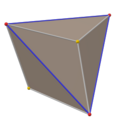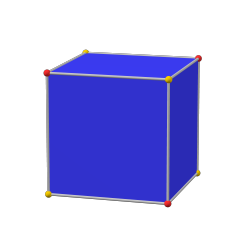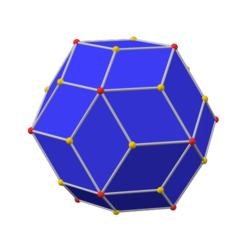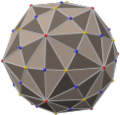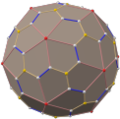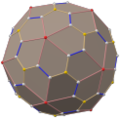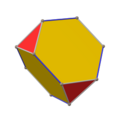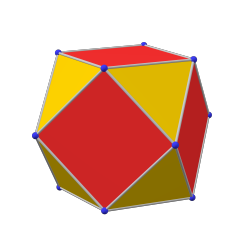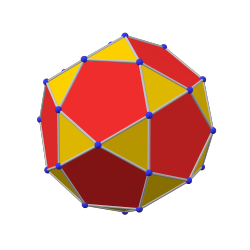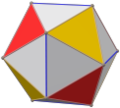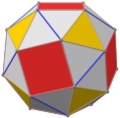Triakis tetrahedron
 In geometry, a triakis tetrahedron (or tristetrahedron[1], or kistetrahedron[2]) is a Catalan solid, constructed by attaching four triangular pyramids of a tetrahedron. As a KleetopeThe triakis tetrahedron is constructed by attaching four triangular pyramids onto the triangular faces of a regular tetrahedron, a Kleetope of a tetrahedron.[3] This replaces the equilateral triangular faces of the regular tetrahedron with three isosceles triangles at each face, so there are twelve in total; eight vertices and eighteen edges form them.[4] This interpretation is also expressed in the name, triakis, which is used for Kleetopes of polyhedra with triangular faces.[2] As a Catalan solidThe triakis tetrahedron is a Catalan solid, the dual polyhedron of a truncated tetrahedron, an Archimedean solid with four hexagonal and four triangular faces, constructed by cutting off the vertices of a regular tetrahedron; it shares the same symmetry of full tetrahedral . Each dihedral angle between triangular faces is .[4] Unlike its dual, the truncated tetrahedron is not vertex-transitive, but rather face-transitive, meaning its solid appearance is unchanged by any transformation like reflecting and rotation between two triangular faces.[5] The triakis tetrahedron can pass through a copy of itself of the same size.[6] The triakis tetrahedron is the stacked polyhedron that is a non-ideal. Combinatorially, it has independent set of exactly half the vertices but is not bipartite, so neither can be realized as an ideal polyhedron.[7][8] Related polyhedronA triakis tetrahedron is different from an augmented tetrahedron as latter is obtained by augmenting the four faces of a tetrahedron with four regular tetrahedra (instead of nonuniform triangular pyramids) resulting in an equilateral polyhedron which is a concave deltahedron (whose all faces are congruent equilateral triangles). The convex hull of an augmented tetrahedron is a triakis tetrahedron.[9] See alsoReferences
External links |
||||||||||||||||||||||||
Portal di Ensiklopedia Dunia




